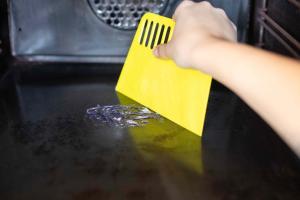Ultimate Guide: How to Clean Melted Plastic Out of an Oven Safely and Effectively

-
Quick Links:
- Introduction
- Understanding the Problem
- Safety First
- Step-by-Step Cleaning Guide
- Preventive Measures
- Case Studies
- Expert Insights
- FAQs
Introduction
If you've ever accidentally melted plastic in your oven, you know how frustrating and concerning it can be. Not only does the melted plastic create an unsightly mess, but it can also emit harmful fumes when heated. In this comprehensive guide, we will cover everything you need to know about safely cleaning melted plastic from your oven.
Understanding the Problem
Melted plastic can occur due to various reasons, such as placing plastic utensils or containers inside the oven. When heated, plastic can adhere to the oven's surfaces, making it challenging to remove. Understanding the composition of the plastic and the materials in your oven is essential for an effective cleanup.
What Happens When Plastic Melts?
When plastic melts, it can release toxic fumes. It can also create a sticky residue that bonds with the oven's surfaces. This residue can be difficult to remove without the right techniques and tools.
Safety First
Before you begin the cleaning process, ensure you have the necessary safety equipment:
- Gloves: Protect your hands from the heat and chemical cleaners.
- Mask: Prevent inhalation of fumes and dust.
- Goggles: Protect your eyes from splashes.
Step-by-Step Cleaning Guide
Step 1: Gather Your Supplies
You'll need the following items:
- Plastic scraper or spatula
- Vinegar or baking soda
- Commercial oven cleaner (optional)
- Microfiber cloths
- Warm, soapy water
Step 2: Pre-Cleaning Assessment
Identify the extent of the melted plastic. If it's a small amount, a scraper might suffice. For larger areas, more intensive cleaning may be necessary.
Step 3: Let the Oven Cool
Ensure your oven is completely cool before attempting to clean it. This will prevent burns and make the cleaning process easier.
Step 4: Scrape the Plastic
Using a plastic scraper, gently scrape away as much of the melted plastic as possible. Be careful not to scratch the oven surface. Use short strokes and work your way from the edges toward the center.
Step 5: Apply Vinegar or Baking Soda
For any remaining residue, apply vinegar or a paste made from baking soda and water. Let it sit for 15-30 minutes to break down the plastic.
Step 6: Wipe Clean
Using a microfiber cloth, wipe the area clean. If there are stubborn spots, repeat the vinegar or baking soda application.
Step 7: Use Commercial Cleaner (if necessary)
If the plastic remains stubborn, consider using a commercial oven cleaner. Follow the manufacturer’s instructions carefully.
Step 8: Final Clean
Once the plastic is removed, clean the entire oven with warm, soapy water to ensure any residue from cleaners is gone.
Preventive Measures
To avoid melting plastic in the future, consider these tips:
- Always check oven settings before placing items inside.
- Use oven-safe containers only.
- Label all plastic items with their heat tolerance.
Case Studies
Several homeowners have shared their experiences with cleaning melted plastic from their ovens:
Case Study 1: The Baking Disaster
A family accidentally left a plastic container in the oven while baking. They followed a similar cleaning process, using baking soda and vinegar, which helped them remove the melted plastic effectively.
Case Study 2: The Overheated Oven
Another homeowner reported that they used a commercial cleaner after failing to remove the plastic with a scraper and vinegar. This method proved effective but required thorough ventilation.
Expert Insights
Experts recommend using natural cleaners like vinegar and baking soda for safety reasons. They emphasize the importance of not using abrasive tools that can scratch the oven's surface.
FAQs
1. Can I use a metal scraper to remove melted plastic?
It's not recommended, as metal scrapers can scratch the oven surface.
2. What if the plastic has burned onto the oven?
In such cases, a commercial oven cleaner may be necessary, but ensure proper ventilation.
3. How can I prevent plastic from melting in my oven?
Use only oven-safe containers and always check before preheating.
4. Is it safe to heat the oven after cleaning melted plastic?
Ensure all residues are removed before heating to avoid harmful fumes.
5. How often should I clean my oven?
Regular maintenance every few months can prevent buildup and accidents.
6. Can I use baking soda alone for cleanup?
Baking soda is effective but works best in conjunction with vinegar for stubborn stains.
7. What are the signs of toxic fumes from melted plastic?
Signs include headaches, dizziness, or respiratory issues. Evacuate the area and ventilate immediately.
8. Is there a specific type of vinegar to use?
Regular white vinegar is effective for cleaning purposes.
9. Can I use a hairdryer to help with melting plastic?
Using a hairdryer can help soften the plastic for easier removal, but be cautious with heat settings.
10. What should I do if I accidentally melt plastic again?
Follow the same cleaning steps as outlined above, and consider preventive measures for the future.
References
For further reading, you can refer to these authoritative sources:
Random Reads
- How to map a network drive
- How to maximize hp laptop battery life
- How to remove paint from walls
- How to remove paint from wood
- How to make a parallel circuit
- How to make a minecraft server on a mac
- How to thin latex paint
- How to throw away trash can
- How to texture paint
- How to turn off windows activation